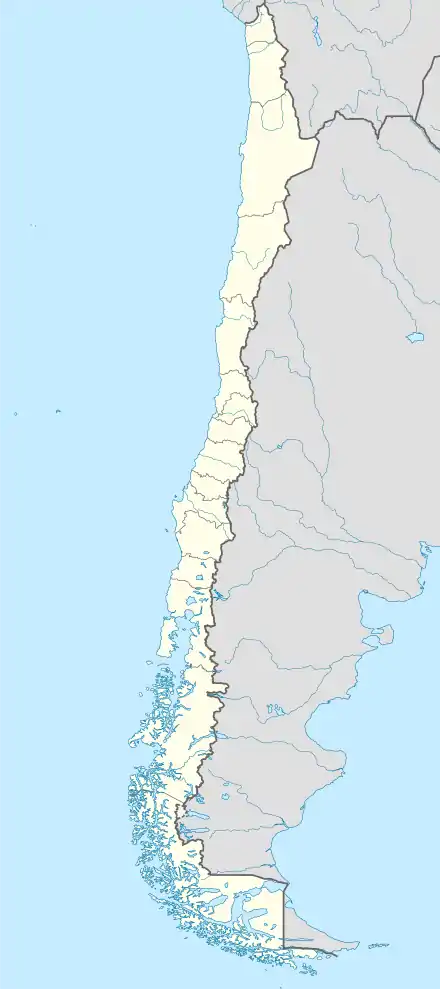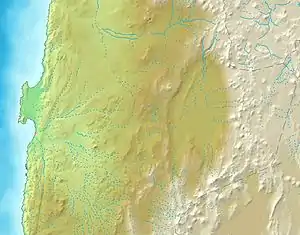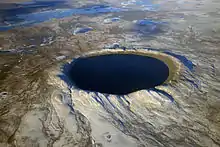Monturaqui crater
Monturaqui is a meteorite crater in Chile. It lies south of the Salar de Atacama and was formed less than a million years ago by an iron meteorite. It is about 455 metres (1,493 ft) wide and contains a salt pan.
 Monturaqui crater | |
| Impact crater/structure | |
|---|---|
| Confidence | Confirmed |
| Diameter | 455 m (1,493 ft) |
| Depth | 31 m (102 ft) |
| Age | ~660,000 years Pleistocene |
| Exposed | Yes |
| Drilled | No |
| Bolide type | Iron meteorite |
| Location | |
| Location | Atacama Desert |
| Coordinates | |
| Country | Chile |
| State | Antofagasta Region |
 Location of the crater in Chile | |
Geography and geomorphology
The crater Monturaqui lies south of the Salar de Atacama[2] and 200 kilometres (120 mi) southeast of Antofagasta[3] and close to a major llama trail.[4] The crater was discovered in 1962 on aerial photographs[5] and first described in 1966[2] and is the first and As of 2008 only known impact crater in Chile.[3]
Local
Monturaqui is circular, about 455 metres (1,493 ft) wide and 31 metres (102 ft) deep[2] and is surrounded by a rim[5] whose height varies between 48–16 metres (157–52 ft) owing probably to pre-existent topography.[6] The crater lies at an elevation of 3,500 metres (11,500 ft); about half ot he mass of Earth's atmosphere is concentrated below this altitude, meaning that the meteorite that created Monturaqui experienced less ablation during its passage through the atmosphere and could create a larger crater.[2] Alluvial material has covered the deepest part of the crater.,[7] which contains a small salt pan that supports several brushes.[8]
General
The basement in which the crater lies is formed by a 0–5 metres (0–16 ft) thick Tertiary-Pleistocene ignimbrite and underlying dyke-containing granites of Jurassic age; both of which crop out in the crater.[9] The terrain on which the crater lies is a tectonic block that was uplifted by 0.6 kilometres (0.37 mi) relative to the Salar de Atacama[2] and which is incised by watercourses that were diverted by the formation of Monturaqui crater.[9]
Impactites have been found around the crater.[9] These include glasses,[7] granitic rocks with evidence of shock metamorphosis as well as metallic iron and nickel but no remnants of the original meteorite.[9] The rocks show evidence of having been exposed to intense heat and pressure during the impact; reconstructed temperatures reached 1,500–3,000 °C (2,730–5,430 °F) with pressures of 50,000,000,000–65,000,000,000 pascals (7,300,000–9,400,000 psi).[10] Based on the chemistry of the impactite, Monturaqui was formed by an iron meteorite.[11]
Age
The crater is relatively old, but certainly younger than the Pleistocene-Tertiary ignimbrites.[9] Thermoluminescence dating yielded highly inexact ages of over 100,000 years ago. Other dating methods based on cosmogenic nuclides yielded an age of 500,000 - 780,000 years ago.[3]
The Atacama meteorites and the Campo del Cielo craters were formerly also associated with Monturaqui;[12] it was proposed that the same celestial body that created Campo del Cielo also generated Monturaqui.[13]
Location
References
- BARRINGER, RICHARD W. (April 1967). "WORLD'S METEORITE CRATERS ("Astroblemes") Version VII, February 1967". Meteoritics. 3 (3): 154. doi:10.1111/j.1945-5100.1967.tb00368.x.
- Bunch & Cassidy 1972, p. 95.
- Valenzuela, M.; Bourlés, D.L.; Braucher, R.; Faestermann, T.; Finkel, R.C.; Gattacceca, J.; Korschinek, G.; Merchel, S.; Morata, D.; Poutivtsev, M.; Rochette, P.; Rugel, G.; Suavet, C. (2008). "New Age Estimation of the Monturaqui Impact Crater" (PDF). Maier-Leibnitz-Laboratorium der Universität München und der Technischen Universität München Jahresberichte. Retrieved 25 August 2018.
- Sanchez & Cassidy 1966, p. 4893.
- Daniel Acevedo; Maximiliano C. L. Rocca; Adriana C. Ocampo; Rabassa, Jorge; Ponce, Juan; Stinco, Sergio (September 2011). "Meteorite impact craters and ejecta in South America: a brief review": 154–155. ISSN 1519-1540 – via ResearchGate. Cite journal requires
|journal=(help) - Sanchez & Cassidy 1966, p. 4891.
- Bunch & Cassidy 1972, p. 107.
- Cockell, Charles S.; Lee, Pascal (2018). "The biology of impact craters – a review". Biological Reviews. 77 (3): 297. CiteSeerX 10.1.1.474.7227. doi:10.1017/S146479310100584X. ISSN 1469-185X.
- Bunch & Cassidy 1972, p. 96.
- Bunch & Cassidy 1972, p. 100.
- Bunch & Cassidy 1972, p. 110.
- BARRINGER, BRANDON (December 1967). "Historical Notes on the Odessa Meteorite Crater". Meteoritics. 3 (4): 166. doi:10.1111/j.1945-5100.1967.tb00289.x.
- Sanchez & Cassidy 1966, p. 4895.
Bibliography
- Bunch, T. E.; Cassidy, William A. (1972). "Petrographic and electron microprobe study of the Monturaqui impactite". Contributions to Mineralogy and Petrology. 36 (2): 95–112. Bibcode:1972CoMP...36...95B. doi:10.1007/bf00371181. ISSN 0010-7999.CS1 maint: ref=harv (link)
- Sanchez, Joaquin; Cassidy, William (15 October 1966). "A previously undescribed meteorite crater in Chile". Journal of Geophysical Research. 71 (20): 4891–4895. Bibcode:1966JGR....71.4891S. doi:10.1029/jz071i020p04891. ISSN 0148-0227.CS1 maint: ref=harv (link)


